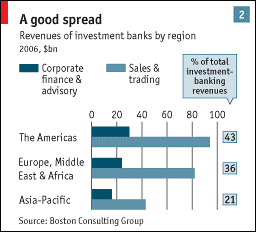The Risks and Returns in Investment Banking
– An 18-page special report on a sophisticated industry
Investment Banking에 관심있는 사람은 읽어볼 것.
source: http://www.economist.com/displaystory.cfm?story_id=9141486
SURVEY: INTERNATIONAL BANKING
The alchemists of finance
May 17th 2007
From The Economist print edition
Global investment banks are taking ever more risk, and are devising ever more sophisticated ways of spreading it, says Henry Tricks (interviewed here). Is that reassuring or worrying?
Maria Jeeves

AT LEAST since 1823, when Byron’s Don Juan described “Jew Rothschild, and his fellow Christian Baring” as the “true Lords of Europe”, investment bankers have inspired awe, envy and, rightly or wrongly, a measure of disdain. Exactly 100 years ago the undisputed patriarch of the modern industry, J. Pierpont Morgan, stemmed the Panic of 1907, a financial crisis caused by unregulated trusts (the hedge funds of their day). Acting, in effect, as lender of last resort from his Wall Street office, he was briefly feted before Americans realised the danger of having such power vested in one man. Cartoonists then mercilessly mocked him. After his death in 1913 the Federal Reserve was set up.
The investment-banking industry was further constrained during the Depression of the 1930s, when Wall Street firms such as that founded by Morgan were split into commercial banks and securities houses. The latter—today’s investment banks—underwrite stocks and bonds and advise companies on mergers and acquisitions, rather than collect deposits and make loans. In the 1980s and 1990s they developed a reputation for gluttonous excess. But a lot has changed since then.
Intensely private partnerships have become publicly traded companies. Commercial banks such as Citigroup and JPMorgan Chase have muscled back into investment banking. And European warhorses such as Deutsche Bank, UBS and Credit Suisse have joined the race for global supremacy. The bets, and the profits, have got bigger, though investment banks are trying to keep quiet about that, for several reasons.
First, they are under more scrutiny. Wall Street firms had their wings clipped by Eliot Spitzer, New York’s former attorney-general, for plugging worthless shares during the dotcom era. Being publicly traded companies has tamed some egos, too. Star traders do not enjoy the same headroom on salaries (albeit very large salaries) as they did when they were partners in the business. At UBS, a Swiss bank which in 2000 moved into the American equity markets by merging with PaineWebber, a brokerage, “fiefs” are explicitly banned. Richard Fuld, boss of Lehman Brothers, a fast-growing Wall Street firm, imposed a “one-firm culture” when it was spun off from American Express in 1994. Now, says Scott Freidheim, a top executive, Mr Fuld uses “culture” in speeches more often than any other word except “the”.
Meanwhile another group has overtaken the investment banks in the excess stakes: their money-spinning clients in the private-equity and hedge-fund industries. Already they throw the biggest parties, do the boldest deals and launch the most celebrated initial public offerings. The IPO of part of Blackstone, a private-equity group, might well raise more money than Goldman Sachs’s did in 1999, when even the company’s doormen and drivers became extremely rich.
 Yet when investment bankers discuss the fabulous fortunes accruing to these firms’ founders, they do so without envy. “Theirs is a truly pioneering role,” says Anshu Jain, head of global markets at Deutsche Bank, one of the world’s top trading banks. “Pioneers in any industry get a disproportionate share of the spoils.”
Yet when investment bankers discuss the fabulous fortunes accruing to these firms’ founders, they do so without envy. “Theirs is a truly pioneering role,” says Anshu Jain, head of global markets at Deutsche Bank, one of the world’s top trading banks. “Pioneers in any industry get a disproportionate share of the spoils.”
Even if they are no longer the pioneers, the investment banks have played a crucial part in bringing about the extraordinary changes seen in the financial markets, starting in the 1980s and accelerating dramatically in the past five years. Technology and innovation have brought unprecedented breadth, depth and richness to financial instruments. According to McKinsey, a consultancy, the stock of shares and public and private debt securities held in America grew from 2.4 times GDP in 1995 to 3.3 times in 2004. In Europe the increase was even more dramatic, albeit from a lower base. These figures do not include derivatives, notional amounts of which traded privately, or “over-the-counter” securities, which had soared to $370 trillion by last June, from $258 trillion less than two years earlier, according to the Bank for International Settlements (BIS). Given such torrid growth, the markets are becoming increasingly vital to global financial stability.
There have been thrills and spills along the way. The stockmarket crash of 1987 and the seizing up of credit markets after Russia defaulted in 1998 both exposed huge flaws in the industry, forcing central banks to step in to prevent what they feared might be lasting damage to the real economy. Even so, regulators reckon that on balance the growth of markets has been a good thing, making the financial system safer than more traditional forms of bank lending. The trouble is that given the complexity of the new instruments and the range of clients and countries involved, they can never be absolutely sure that a monumental crisis is not brewing somewhere.
What worries both bankers and regulators is not so much the threat from hedge funds or private-equity groups but the implications for the financial system of a possible collapse of an investment bank (or large complex financial institution, as they clumsily call it). At a time when America’s housing market has exposed the danger of overexcitement on Wall Street, it is worth exploring how these institutions are evolving, how they handle the risks attached to what they do, and how well those risks are spread around the financial system. That is what this survey sets out to do.
Risk-takers Anonymous
Investment banking is in a state of evolution rather than revolution. The essence of the business has always been taking calculated (and sometimes miscalculated) risks. But now traders place bets in more places, with more clients and using more complicated gambling devices than ever before.
Brokerage used to be described as a haulage business, lugging money, as a member of the Rothschild dynasty once put it, “from point A, where it is, to point B, where it is needed”. The idea of describing themselves as glorified delivery men may well still appeal to the cynics on the trading floor who work with shirtsleeves rolled up and hail each other loudly in Brooklyn or mock cockney accents. But any haulage firm would be flabbergasted by the trading profits and returns on equity seen in investment banking in recent years, especially among Wall Street’s big “bulge-bracket” firms. Svilen Ivanov, head of capital markets at Boston Consulting Group, notes that earnings from capital-market-related activities at the top ten global investment banks have risen by almost two-thirds in two years, from $55 billion in 2004 to $90 billion last year. That sort of profit increase is comparable with Apple’s rewards for inventing the iPod, he points out. Yet in investment banking there is nothing nearly so tangible to which to ascribe the gains.
Bankers themselves are fuzzy about explaining their trading profits, bandying about phrases such as “deploying our intellectual capital”. But it is clear that three powerful forces are at work, all of them overlapping and mutually reinforcing, and all fundamental to the gushing liquidity the world is currently enjoying.
The first is the alchemist’s trick of turning debt (mostly leaden) into derivatives (mostly liquid); the second is the emergence of a new class of leveraged client (hedge funds and private equity); and the third is seeking out new capital markets, and clients, around the world. Moreover, in all these pursuits the firms are now using not just their clients’ money but, to differing degrees, their own too.
Joseph Perella, an industry veteran who last year struck out independently with an advisory boutique, Perella Weinberg, observes that putting a firm’s own capital into mergers, acquisitions and other transactions is one of the biggest changes in investment banking since the 1980s. “It’s not just one firm sticking its neck out. It’s across the board.”
But using the banks’ own capital creates potential conflict. Not only do they risk putting their own interests before those of their clients; they are also increasingly exposing themselves to the dangers of an abrupt turn in the credit cycle. They are arranging ever bigger debt issues for private-equity firms and hedge funds and so are encouraging a borrowing binge that could breed financial instability. For the time being all this is hugely profitable. But it is also making the banks far too complacent for their own good.
The driving force behind all this has been an unusually benign economic climate. The global economy is at its least volatile since the 1960s, real interest rates are low and companies are generating huge profits. What some call “the great moderation” has been a boon to financial markets around the world, particularly those trading in the multifarious debt instruments concocted in the laboratories of Wall Street and the City of London. The opening up of Asian economies has brought down the price of traded goods, helping to fight inflation. Meanwhile, high savings rates in that part of the world, combined with ageing populations in the West, have helped to push up demand for long-term investment instruments such as bonds.
At the same time the search for yield, as investors seek to compensate for low returns in high-quality markets such as government bonds, has increased demand for instruments of greater complexity, such as credit-default swaps (CDSs), collateralised debt obligations (CDOs) and other derivatives. That has pushed down implied volatilities to multi-year lows, arguably making the assets appear more reassuring than they actually are.
Regulation has helped, too. Under the Basel 2 banking accord, whose trickier provisions are due to come into force in the European Union next January and in America starting a year later, capital will be allocated according to the riskiness of assets. That has encouraged banks to make more use of credit derivatives to diversify their credit portfolios, and to sell more assets into the capital markets to be repackaged into debt securities.
All of which means that investment banks have generated many of their trading profits from derivative trades—with each other, with their banking clients or with hedge funds which increasingly use the instruments as speculative tools. The demand for loans to repackage into securities, such as CDOs, has helped fuel the generous credit conditions that have underpinned private equity’s leveraged buy-out (LBO) boom as well.
The wild east
To cap it all, over the past few years markets around the world have opened up in a way unmatched since before the first world war, and investment banks have seized the opportunity to expand internationally. Since the start of the 20th century, when America first emerged as an economic power, the world’s financial-market activity had increasingly gravitated towards American share and bond markets. The introduction of the euro in 1999, and the rapid growth of economies in Europe and Asia, lured investment bankers in the other direction. The share of investment-banking fees earned from Europe was growing long before America’s regulators woke up to the damage caused to American markets by aspects of the Sarbanes-Oxley act and other red tape. Last year, by some estimates, revenues from Europe and Asia overtook those from America for the first time (see chart 2).
 In the meantime London has become an impressive rival to New York as a global financial centre. Michael Klein, the boss of corporate and investment banking at Citigroup, describes Britain’s capital as New York, Chicago, Houston and Washington, DC, rolled into one, because it trades all the assets of the first three and is regulated on the spot as well. Instead of Greenwich, Connecticut, it has Mayfair for hedge funds. London, moreover, is a hub for Europe, and stronger economies on the continent mean growing markets for capital; typically, such markets increase at double the rate of GDP when economies expand.
In the meantime London has become an impressive rival to New York as a global financial centre. Michael Klein, the boss of corporate and investment banking at Citigroup, describes Britain’s capital as New York, Chicago, Houston and Washington, DC, rolled into one, because it trades all the assets of the first three and is regulated on the spot as well. Instead of Greenwich, Connecticut, it has Mayfair for hedge funds. London, moreover, is a hub for Europe, and stronger economies on the continent mean growing markets for capital; typically, such markets increase at double the rate of GDP when economies expand.
London’s position as a springboard for emerging markets vastly increases its allure. America and Europe between them may still account for almost four-fifths of all investment-banking revenues, but fees are growing fastest in the developing world. That reflects the might of companies such as Gazprom, Russia’s energy behemoth, and the recently listed Industrial and Commercial Bank of China, which Mr Klein admits are both vying with Citigroup in size. He notes that 140 of Citigroup’s top 1,000 clients are from emerging markets, whereas 15 years ago the number was only 40. Russia and China are among the world’s biggest IPO markets. And many developing countries are seeking to strengthen their domestic capital markets, which means that the biggest global investment banks—such as Citi—hope eventually to deploy enormous resources there: trading desks of perhaps 1,000 people, not 25.
Given the markets’ increasing complexity, how do investment banks manage the growing risks they face? There are lots of things they need to do, from finding enough brainboxes capable of handling the intricate assets being created to measuring the correlations between instruments that are supposed to spread risk but may do the opposite if liquidity dries up. It is mildly reassuring that hardly a week goes by without regulators in the world’s main markets pressing the industry to improve its risk-management techniques—but rather worrying that the same regulators pay considerably less attention to where the risk may end up.
Maria Jeeves

Investment bankers themselves have a vested interest in not blowing up their firms. The biggest banks are thought to be investing hundreds of millions of dollars a year in technologies to measure risk and stress-test it. Comfortingly, regulators who scrutinise the banks’ risk-weighted capital say it is stronger than ever. But capital is only one line of defence. The banks’ ability to cope with liquidity crises and credit crunches is harder to gauge.
Financial markets send out mixed messages about the confidence of investors in the institutions themselves. The investment banks’ share prices appear to reflect the belief that their equity will be safeguarded rather than that earnings will be stable. As David Viniar, chief financial officer of Goldman Sachs, puts it, the firm, whose risk appetite is second to none, has increased revenues in 18 out of the past 21 years, but quarterly income has been more volatile. “It’s a growth business and it’s not going to get more stable,” he says.
Taking risks and managing them is an investment bank’s core business. Bankers believe risk-taking is how their industry supports entrepreneurs and hence economic growth. The trouble is that new risks are almost invariably explored before there is a good way to measure them.
Ultimately, business and credit cycles tend to reveal which risks are excessive—and whatever junior traders may think, the business cycle is far from dead. Richard Portes, professor of economics at the London Business School, recalls first debating its possible demise back in 1969. Since then he has discovered a comment by Leon Fraser, an American banker, speaking after the great crash of 1929, which convinced him that boom-bust cycles in finance will always be with us. Mr Fraser’s immortal words were: “Better to have loaned and lost than never to have loaned at all.”



No Responses to “The Risks and Returns in Investment Banking”
Please Wait
Leave a Reply